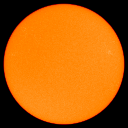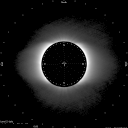-
http://www.SpaceWeather.com/
NASA site that features SunSpots, Aurora-Alerts,
Comets & Close-approach asteroids.
Solar-Astronomy & Ham-SW-reception
-
http://www.SkyMaps.com/downloads.html
http://www.MidnightKite.com/starcharts.html
http://www.Asahi-net.or.jp/
SkyMaps Provides a really nice map of the sky for the
current month (N & S hemisphere, he's an Aussie)
retrieve/save/print these each month...
they provide a nice list of things to look for
with 1)Eye, 2)Bino & 3)SmallScope
categories.
SFA's Dan Bruton provides a 4-page printable (.pdf) Atlas
Japan: T.Taki provides a 12-page printable (.pdf) Atlas
-
http://www.JB.man.ac.uk/almanac/
Astronomers use a computed almanac to determine exactly where
an object will be in the sky on a given date/time from a specific
location. When available, a computer-almanac is preferred.
The classic reference is the annual
USNO Ast-Almanac.
See the RASC annual Handbook (below) for amateur needs.
-
http://APoD.nasa.gov/
a presentation (new one each day, since Jun 1995)
of some interesting astro-space image.
usually research/Hubble-grade, sometimes amateur,
but give excellent views & detail of something...
has a good 'calendar' feature to locate prior photos...
take a look at 08Nov1999 of the moon...
http://www.LPoD.org/ has a Lunar Photo each day.
-
http://Heritage.STSCI.edu/
the "Best of the Hubble Telescope"
chosen (one per month?) as a 'pretty space photo'.
http://www.aao.gov.au/images.html/general/favorites.html
Favorite-Fifty-Fotos from Down Under
-
http://www.TheNakedSky.com/
a basic and straight-forward one-page
"what to look for" this month.
Send the author an Email-thank-you note to encourage
continuing to provide it...
-
http://SkyAndTelescope.com/observing/skychart/
an OnLine Star Chart that runs in your browser
set your location (by Country-City or Lat-Long)
change Date/Time and see WaaaSsupp !
-
http://SkyAndTelescope.com/news/
A popular amateur astronomy magazine Sky & Telescope
provides a weekly astro-space news column (many other
resources, too). It can be viewed online and there is
an Email-subscription option.
-
http://Comets.AMSmeteors.org/
Comets are known as Dirty-SnowBalls and can come visit our
inner-solar-system from the cold-dark areas beyond the planets.
Gary Kronk is currently writing a Comet Encyclopedia
with everything we know about comets and prior visits.
-
http://www.LunarRepublic.com/atlas/
http://www.Google.com/moon/>
An OnLine Photographic Lunar Atlas
-
http://Cmex-www.arc.NASA.gov/Atlas96/Atlas96.htm
http://Mars.Google.com/
An OnLine Photographic Mars Atlas
-
http://www.MrEclipse.com/
basically a NASA site as MrEclipse ( Fred Espanak)
is the renowned Solar-Eclipse chaser for NASA...
-
http://www.CurrentSky.com/
a basic 'what to look at' web-site. PDA friendly
-
http://www.SolarViews.com/eng/homepage.htm
good overview of PLANETARY-astronomy
and a section of History-People
- learn the constellations:
http://www.StarShine.com/frankn/astronomy/constellations.asp
http://www.AllTheSky.com/
http://www.AstronomyBoy.com/constellations/
-
http://www.PhotosByThad.com/
a photographer with an interesting Night-Photography style,
and some really nice Astro-Photos in his collection
-
http://Groups.Yahoo.com/group/digital_astro/
AstroPhotography is an interesting and rewarding hobby...
these days, to start, anyone should consider Digital
instead of film... there are many advantages of each.
-
http://dir.Yahoo.com/science/astronomy/
see 'astronomers' section for some Bio's and
brief summaries of noted historical astronomers work.
other sections give good variety/overview topics.
-
http://www.StarDate.org/resources/ssguide/
http://www.StarDate.org/resources/btss/
the UTexas Astro dept has an interesting online
guide for the SolarSystem and Galaxies.
( guías en
español, tambien )
http://www.AstroRED.org/
http://www.Astro.Indiana.edu/startrak.shtml
http://www.Astro.Indiana.edu/startrak_spanish.shtml
- British Astronomy Links
http://www.PopAstro.com/home.htm
http://www.ROG.NMM.ac.uk/
http://www.AstronomyNow.com/
- parlez-vous français?
http://www.Planetarium.Montreal.qc.ca/
- sprechen Sie Deutsch?
http://www.NAA.net/
http://www.WonderPlanets.de/
-
http://www.AstronomyNotes.com/
A basic astronomy-text-book online
and a couple that go a little deeper...
http://Zebu.UOregon.edu/text.html
http://www.Astronautix.com/
-
http://www.NationalGeographic.com/stars/chart/index.html
A "good" sky atlas online is hard to find.
this one is just fine... for starters.
or you can select Location/Time and generate a SkyView
http://www.MyStarsLive.com/
( easy to download/install/use ShareWare version, too )
-
http://www.Heavens-Above.com/
an online astrometry resource.
locate objects in the sky from your observing site
-
http://LiftOff.MSFC.nasa.gov/realtime/jtrack/Spacecraft.html
NASA site for tracking major satellites and the shuttle (when UP)
see the current location of: HST, ISS, Chandra and
StarShine
-
http://www.TexasStarParty.org/
The Texas Star Party meets each Apr/May near Ft.Davis
a week-long star-watching convention of some 650+
astro-wannabees. No experience necessary.
Plan to make reservations by late Jan, as it fills up.
-
http://www.AstroMax.org/astrocourse/history.htm
an excellent 'Observing Programs' for various astro-interests.
Site has links to many good beginner pages.
-
http://www.seds.org/Messier/
When you step outside and look at the sky, you see stars.
With a binocular or a modest telescope with DARK-skies
and knowing where and when to look...
you begin to see: Emission Nebulae, Planetary Nebulae,
Open clusters, Globular clusters and distant Galaxies.
These are what were found by Charles Messier back in ~1770+...
he was a comet-hunter and was distracted by comet-like
objects that did not move through the sky from night to night
and he made a list of the fuzzies that he found...
they are the prettiest variety of beginning deep sky objects...
This link provides a list of the Messier Objects,
and what type it is and... a picture...
-
http://www.SupplementWatch.com/suplib/supplement.asp?DocId=1043
Night Vision: in the dark of a moonless night, the "cones" (color) on your
retina are not receiving enough light to function, the "rods" (light) receive
the faint ambient light and twinkle from the stars as just (White) light.
The ability of the eye to adjust and function in the low-light conditions can
easily affect your enjoyment of astronomy. It can easily take 20-30 minutes
for the eye to adjust to the dark and just a moment of "white-light" will
re-start the adjustment (see Red Lights, below). Knowledge of the internals
of the eye are beyond my knowledge, but I recently heard that a component of
"Blue Berries", called anthocyanin, is helpful to the eye for dark adjustment.
So, eat your Blue-Berry Muffin or add berries to your cereal for breakfast.
Or check your drug-store "vitamins" for 'BilBerry Extract'. I found 1 gram,
60-softgel Rexall
bottle at Walmart for about $3.60, about a nickel per capsule...
one or two per day. After I've consumed a couple bottles and have some reason
to assess any affect, I'll mention it here. ...
usual common sense cautions are in effect for self-prescribing herbs and vitamins.
-
http://www.SquidLight.com/
http://www.TadGear.com/ Glo-Toob™
http://www.9VoltLight.com/
http://www.GerberBlades.com/
http://www.CFRlights.com/
http://www.MagLite.com/
http://www.RigelSys.com/
When you are out observing and your eyes have adapted
to the dark night and you try to consult your almanac,
atlas or notes, you need to have a RED light.
MagLite has their 2xAAA & 2xAAA lights with red-filters.
MagLite is supposed to be working on LED lights for later in 2003.
Gerber(CMG) has their Infinity in White or RED LED
CFR is a good source for Gerber(CMG) lights.
Rigel has a variable-brightness-dual-RED-LED light.
-
http://www.pa.MSU.edu/abrams/SkyCalendar/
$11/year
This is a monthly (3 per mailing) Sky Calendar of what to look
for during the month, mostly naked-eye or maybe using binoculars.
-
http://www.ShopAtAky.com/ Atlases, Maps & Globes
Pocket Sky Atlas $20 Item#59317
An excellent and convenient all-sky Star-Chart/Atlas.
-
http://www.WillBell.com/atlas/atlas1.htm
$10
a must have Sky/Star road map.
Learn to read a
Map & Chart from S&T
or R.Bell
-
http://www.RASC.ca/publications/
Observer's Handbook 2008 $32
Observer's WallCalendar 2008 $20
the HandBook (100thEd.) is GREAT...
I have each issue, since about '81...
It is a thorough reference for going out to look at the skies...
The wall-calendar is really nice. Available in September.
-
http://www.ScientificsOnline.com/ $250
Edmund Scientifics in New Jersey has an excellent pair
of Fujinon 7x50 Individual-Eyepiece-Focus binoculars
at a great price. Search for SKU CR30534-59.
A good pair of binoculars are always handy to check
some area of the sky for details, and they can be easily
used for other activities, unlike an Astro-Telescope.
NOTE: these binoculars are Nitrogen-Filled,
so, do NOT let any of your friends try to un-screw
the objectives for a closer inspection, no matter how much
they claim to know about binocular optics.
|





